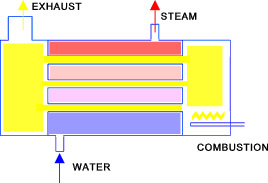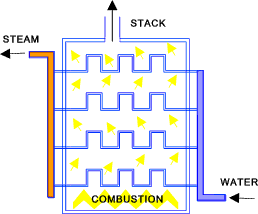Thermos Index
Boilers
Introduction.....
Boiler Types.....
Boiler Operation.....
Fire Tube Boilers.....
Water Tube Boilers.....
Boiler Auxiliaries....
Standards.....
Boiler Efficiency.....
Fuels.....
|
Introduction A boiler is a closed vessel in which water or other fluid is heated under pressure. The steam or hot fluid is then circulated out of the boiler for use in various process or heating applications.. The boiler system includes two prime processes
The efficiency of the heat transfer process is known as the transmission efficiency The overall efficiency is known as the boiler efficiency The boiler efficiency = Energy transmitted to Fluid / Heating value or calorific value of fuel Types of BoilersThere are two principle types of boilers,fire tube boilers and water tube boilers. Fire Tube Boilers...Fire-tube boilers force hot combustion gases through tubes submerged in water.
Water Tube Boilers circulate water in tubes within a furnace enclosure. Hot flue gases pass over the tubes, heat the water, and then exit through a stack.
Water-tube boilers are usually specified in all situations where operating pressures of 20 barg or greater are required because of their greater structural integrity. Fire-tube boilers are usually preferred in low-pressure applications between 0,5 kg/s (approx. 75kW) and 5kg/s (approx. 750kW boiler ) of steam. In sizes below 0,5kg/s and above 5 kg/s, water-tube units are often preferred. Boiler Operation Energy is continuously added to water in a closed system (vessel or piping) array and the water evaporates to steam and the pressure and temperature increases as long as the strength of the containment is not exceeded. The relationships between temperature, pressure and volume of the contained fluid are shown in steam tables. There will be a point where the energy supplied is just sufficient to maintain steam conditions and evaporation will stop.... If the contained steam is released to drive a turbine or engine the pressure will tend to fall allowing increased evaporation. So long as the temperature is maintained constant the pressure will also be constant as it supplies steam, under steady conditions, to the plant being driven. The operation of the boiler is controlled to ensure a sufficient supply of water to make up for the steam being supplied and to ensure sufficient energy input to maintain constant pressure in the steam system. In modern boilers over 80% of the heating value of the fuel is transmitted to the fluid in the boiler. The rest of the heating value is lost in the exhaust gases or is lost by conduction radiation and convection on the external surfaces of the boiler system.. A vital part of any boiler system is the system designed to release the steam pressure to ensure safe conditions are maintained. The safety system is generally based on using high integrity safety relief valves. Fire Tube Boilers Fire Tube Boilers are widely used in small installations to heat buildings and to provide power for factory processes. Fire-tube boilers are also used in steam locomotinves Fire-tube boilers have the advantage of being easy to install and operate. The main disadvantage of the fire tube boiler is that the steam is generated in a large containment vessel which is at risk of catastrophic failure due to the high stresses developed at high pressures.... Water Tube Boilers Water tube boilers were developed to satisfy the the demand for large quantities of steam at pressures and temperatures far exceeding those possible with fire-tube boilers. The tubes are outside the steam drum, which has no heating surface and is much smaller than in the fire-tube boiler. For this reason, the drum of the watertube boiler is better able to withstand higher pressures and temperatures. A wide variety of sizes and designs of watertube boilers are used in power stations, ships and factories. Water tube boilers have the following advantages.
Boiler Auxiliaries The following auxiliaries are mostly applicable to industrial scale water tube boilers a) De-aerating Plant De-aerating plant is often used before the economizer and boiler to remove gases and thus prevent corrosion. De-aration also avoids air passing, with the steam, into the condensor are reducing the necessary vacuum. Turbine operation Pressurised water at about 1,5 barg is sprayed into a chamber which is at a reduced pressure relative to the feed water. The chamber is fed with steam. The reduction of pressure and the heating of the water particles by contact with the steam results in the liberation of the gases from the water. b) Feed Heaters Feed Heaters are used for supplying boilers with hot feed water. An important benefit of feed heaters is that most of the dissolved gases are liberated before the feed water enters the boiler. The feed water flow passes through tubes which are exposed to partially expanded steam brought from, typically, one or more points in the turbine system. The turbine exhausted steam is thus used to some advantage. It has been established that heating the boiler feed water is this way improves the overall efficiency of the turbine plant. c) Economizer Most of the energy waste in the boiler system is in the waste heat in the exhaust gases routing to the stack (chimney). The economizer is often used to enable feed water to be preheated by routing the feed water through banks of water pipes (economizer) through which the exhaust gases are diverted. d)Superheater The steam generated from water in the boiler drum is saturated steam which does not attain a unity dryness value- it is wet steam. Turbine plant is generally operated at higher efficiency if the turbine feed steam is superheated. To superheat the steam it is fed from the boiler drum via banks of steam tubes (superheater) through the region of the combustion chamber where the hottest gases are flowing. The superheater only slightly increased the boiler efficiency but there is a significant benefit in the turbine efficiency because there is a reduced steam consumption in the turbine or engine resulting from use of superheated steam. Reference Standards BS EN 12953-1:2002...Shell boilers:General BS EN 12953-2:2002...Shell boilers:Materials for pressure parts of boilers and accessories BS EN 12953-3:2002...Shell boilers:Design and calculation pressure parts BS EN 12953-4:2002...Shell boilers:Workmanship and construction of pressure parts of boiler BS EN 12953-5:2002...Shell boilers:Inspection during construction, documentation and marking of pressure parts of the boiler BS EN 12953-6:2002...Shell boilers:Requirements for equipment for the boiler BS EN 12953-7:2002...Shell boilers:Requirements for firing systems for liquid and gaseous fuels for the boilers BS EN 12953-8:2002...Shell boilers:Requirements for safeguards against excessive pressure BS EN 12953-10:2002...Shell boilers:Requirements for feedwater and boiler water quality BS EN 12953-11:2002...Shell boilers:Acceptance tests BS EN 12953-12:2002...Shell boilers:Requirements for grate firing systems for solid fuels for the boiler BS EN 12953-13:2002...Shell boilers:Guidelines for the involvement of an inspection body independent of the manufacturer Boiler Efficiency The boiler efficiency is based on the calorific value of the fuel used and the enthalpy change from water to steam. Notes on the calorfic value of the fuels are provided below...
Boiler Fuels A boiler can be fueled using solid , liquid, or gaseous fuels. Below are a list of fuels with the relevant calorific values . The calorfic value is the quantity of heat obtained per kilogram for solid or liquid fuel or per m3 for gaseous fuel when burnt with an excess of oxygen in a calorimeter. If H 2O is present in the products of combustion as liquid then the Higher Calorific value ( HCV) results from the test. If H 2O is present in the products of combustion as a vapour then the Lower Calorific value ( LCV) results.
For combustion Notes Combustion Notes ....More notes to follow.... |
||||||||||||||||||||||||||||||||||||||||||||||||||||||||||||||||||
Links To Boilers
|
|
Thermos Index

